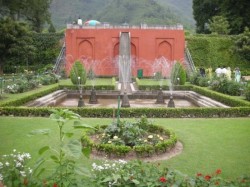Srinagar
|
Srinagar : The old city huddles with houses, with narrow streets as suited the past when no conveyances worth the name plied,. here you find the grand mosques, the fort and the hillock of hariparbath with shrines of the religious atop, The shrine at Hagratbal the repository of the sacred relic of the hair of the prophet, the shankracharya hill commanding the view of entire city. The four Mughal gardens laid superbly by the Mughal emperors around the Dal Lake Namely A Nice Getaway : If one wats to really get away from the chaotic city life all then Nagin is a good place to find a house boat and do it the surroundings are much more serene and isolated than on Dal Lake. One can rent rowboats from the camping site here – either to simply row around the lake or to look around for a houseboat. |
|
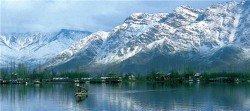 |
#City Of Lakes |
| #SHALIMAR BAGH (abode of Love) The Shalimar were built by Emperor Jehangir for his wife Nur Jahan, ‘light of the world’ in 1616. Although it is known today as the ‘garden of love’ it was originally named the Farah Bakhsh or ‘delightful garden’. The garden is built in four terraces with traditional water channel running down the middle. The gardens measure 540 by 183 metres. During the Mughal period the top terraces used be reserved for the emperor and the ladies of the court and was the most magnificent. It included a pavilion made of black stone in the middle of the tank. Black Marble fluted pillars supported the pavilion, which was used as a banquet hall. Shalimar Bagh has an air of seclusion and repose, and its rows of fountains and shaded trees seem to recede towards the snowcapped mountains. A Son Et Lumeiere or sound and light show is put on here every evening during the May to October tourist season. |
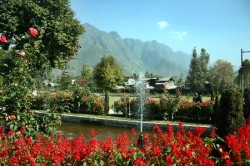 |
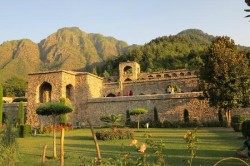 |
#PARIMAHAL ( an observatory in ruens alongside the cheshma shahi garden) The old Sufi college of Pari Mahal, the ‘palace of the fairies’, is only a short distance above the Chasma Shahi gardens. One can easily walk from the gardens up to the Pari Mahal then follow a footpath directly down the hill to the road that runs by the Oberoi Palace Hotel. The Pari Mahal consists of a series of arched terraces. Recently it has been turned into a very pleasant and well-kept garden with fine views over Dal Lake. It’s attractively sited on a spur of the Zabarwan Mountains. The gardens are beautifully kept even today and a Son Et Lumiere show is put on here every evening during the May to October tourist season. |
| #NISHAT BAGH ( Garden of Pleasure) The Nishat Bagh is another lovely garden with its 12 terraces representing the 12 signs of the zodiac, which descend gradually and seem to almost merge into the lake. It is situated on the banks of world famous Dal Lake in the backdrop of Zabarwan hills. With its flowerbeds, trees, fountains, the Nishat presents a dramatic sight. The gardens were designed in 1633 by Asaf Khan, brother of Nur Jahan, and follow the same pattern as the Shalimar gardens with a polished stone channel running down the centre and a series of terraces. It’s the largest of the Mughal gardens measuring 548 metres by 338 metres, and often the most crowed. The walks beside the channel are bordered with lines of cypresses and Chinars. Also found within its vicinity are some remains of Mughal period buildings including a double storey pavilion enclosed on two sides latticed windows. Directly behind the garden is the Gopi Tirth, a small spring gushing forth crystal clear water, which feeds the garden water. |
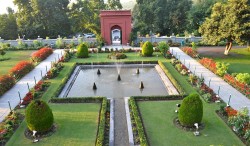 |
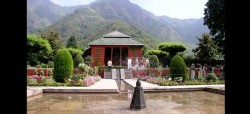 |
#CHASMA SHAHI (Royal Spring) Cheshma Shahi is the first Mughal garden one will pass after Nehru Park. Built at a height above the city, its views are as stupendous as its layout. The smallest of Srinagar’s Mughal gardens, Cheshma Shahi has only three terraces in addition to a natural spring of water enclosed in a stone pavilion. Smallest of the Srinagar Mughal gardens, measuring just 108 metres by 38 metres, the Chasma Shahi, or ‘Royal Spring’, are well up the hillside, above the Nehru Memorial Park. The fresh water spring in these pleasant, quieter gardens is reputed to have medicinal properties. The gardens were laid out in 1632 by Ali Mardan Khan and include three terraces, an aqueduct, waterfalls and fountains. The water from the spring supplies the fountains and then goes through the floor of the pavilion and falls to the lower terrace in a fine cascade of five metres, over a polished black stone chute. Some extensions have recently been made to the gardens. Like all the gardens the Chasma Shahi is open from sunrise to sunset but unlike the other gardens this is the only one, which charges admission. There is a small shrine, the Chasma Sahibi, near the gardens, which also has a fresh water spring. |
| #DAL LAKE The Dal is famous not only for its beauty, but for its vibrance, because it sustains within its periphery, a life that is unique anywhere in the world. The houseboat and Shikara communities have lived for centuries on the Dal, and so complete is their infrastructure on the lake, that they never have to step on land! Doctors, tailors, bakers- one can see them all in tiny wooden shops on the lake, near picturesque vegetable gardens and acres of lotus gardens. The most confusing parts of Srinagar for it’s not really one lake at all, but three. Further more much of it is hardly what one would expect a lake to be like – it’s a maze of intricate waterways and channels, floating islands of vegetation, houseboats that look so firmly moored they could almost be islands and hotels on islands which look like they could simply float away. Dal Lake lies immediately to the east and north of Srinagar and stretches over 5-km. The lake is divided into Gagribal, Lokut Dal and Bod Dal by a series of causeways The main causeway across the lake carries the water pipeline for srinagar’s main water supply. Dal gate, at the city end of Dal Lake, controls the flow of the lake into the Jhelum river canal. It’s the steady flow of water through the lake, combined with its relatively cold temperature, which keeps it so clear looking. |
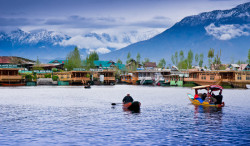 |
|
|
#MUGHAL GARDENS Kashmir was a favourite of the Mughal emperors who visited it as often as they could. Cool and refreshing after the plains of North India where the business of governance kept them, they planted gardens with stepped terraces and flowing watercourses. When they rested in their gardens, they dreamt they were in paradise. The next garden along the road that encircles the Dal is the Nishat, built by empress Nur Jahan’s brother Asaf Khan. The largest of the gardens, Nishat has several terraces, a central watercourse and a majestic site between the Dal and the Zabarwan hills. The third Mughal garden – the Shalimar – was planted by Jehangir, the Mughal emperor, whose love for Kashmir was legendary. Shaded by magnificent Chinar trees, the Shalimar is a series of stone pavilions and flowing water with paint box bright flowerbeds. |

